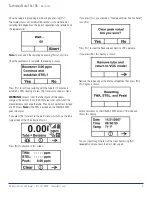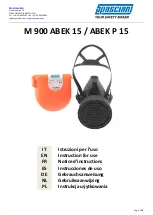
Technical Note TN-136
06/10/TM
RAE Systems by Honeywell 877-723-2878 raesystems.com
2
To begin measuring, turn on the UltraRAE 3000. This screen is
shown, which includes the CF (correction factor) and measurement
gas type (benzene, butadiene, etc.) for calibration reference:
Press [N/-] to advance. You will see this screen:
Do not begin sampling yet!
Before you start sampling, you must insert a RAE-Sep separation
tube into the inlet/holder. Follow the Separation Tube Preparation
and Placing A Tube Into The UltraRAE 3000 instructions before
pressing any buttons on the UltraRAE 3000. Once the tube is in
place, then proceed to measuring.
IMPORTANT!
Once a tube’s ends are broken off, the material
inside is exposed. Therefore, use the tube for sampling as soon as
possible.
Separation Tube Preparation
CAUTION!
Wear hand and eye protection when breaking tube tips.
Use caution in handling tubes with broken ends. Keep away from
children. RAE-Sep tubes should be disposed of according to local
regulations. See footnotes of data sheets for disposal information.
1.
Open a package of RAE-Sep separation tubes and remove one.
2.
Place the tip in the package’s tube tip breaker (the
small hole on the front) and snap off the tip.
3.
Turn the tube around and snap off the other end.
CAUTION!
Handle tubes with care. Tube ends are sharp after ends
are broken off.
Inserting The Separation Tube
1.
Unscrew the front of the sampling probe from the base.
2.
Slip the tube into the rubber holder in the front portion.
3.
Insert the other end of the tube into the middle of the base while
turning the front portion to tighten it onto the base’s threads.
IMPORTANT!
Do not overtighten any portion of the sampling
assembly.
MEASURING
WARNING!
If a 15-minute test is performed and less than 1/4 of
the tube is not yellow-orange at the bottom, retest with a new tube
for 1 minute. If at least 1/4 of the tube is not yellow-orange at the
bottom, the test should not be considered valid, and VOCs may be
dangerously high.





















